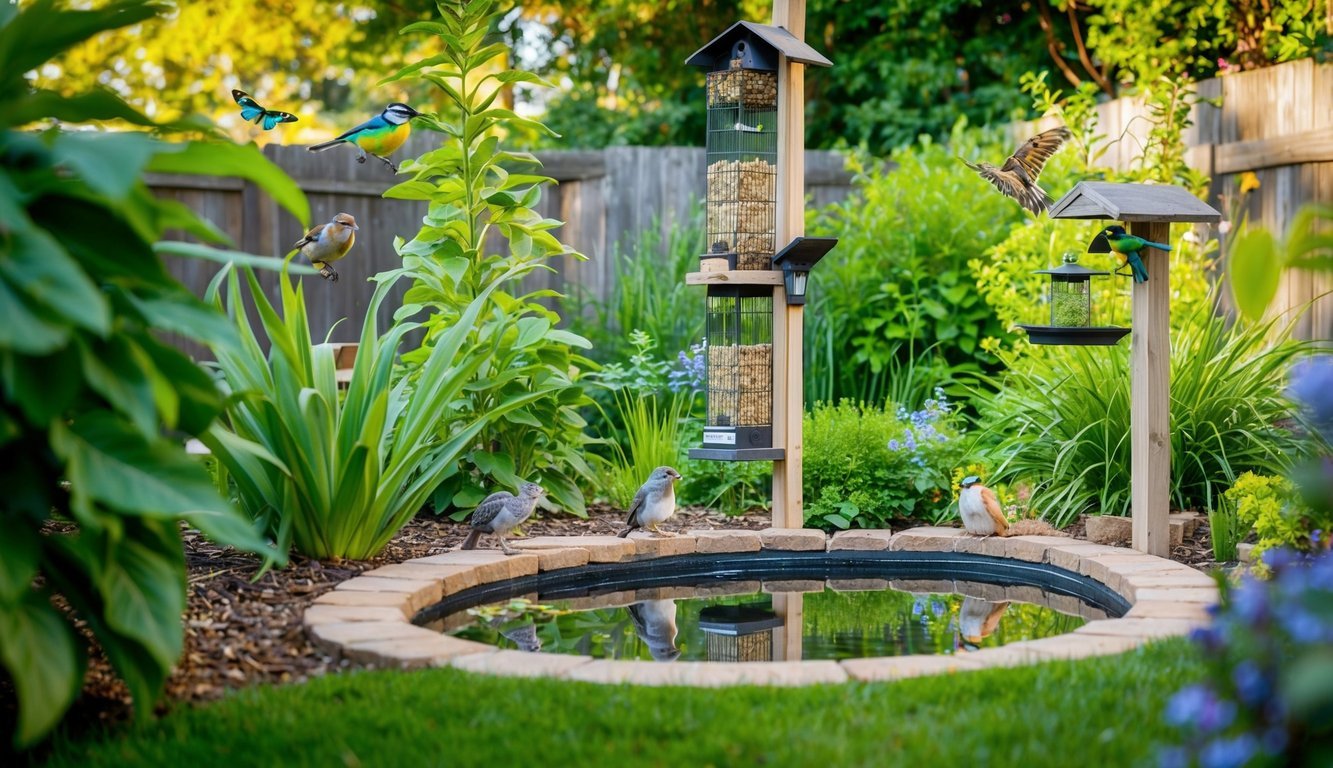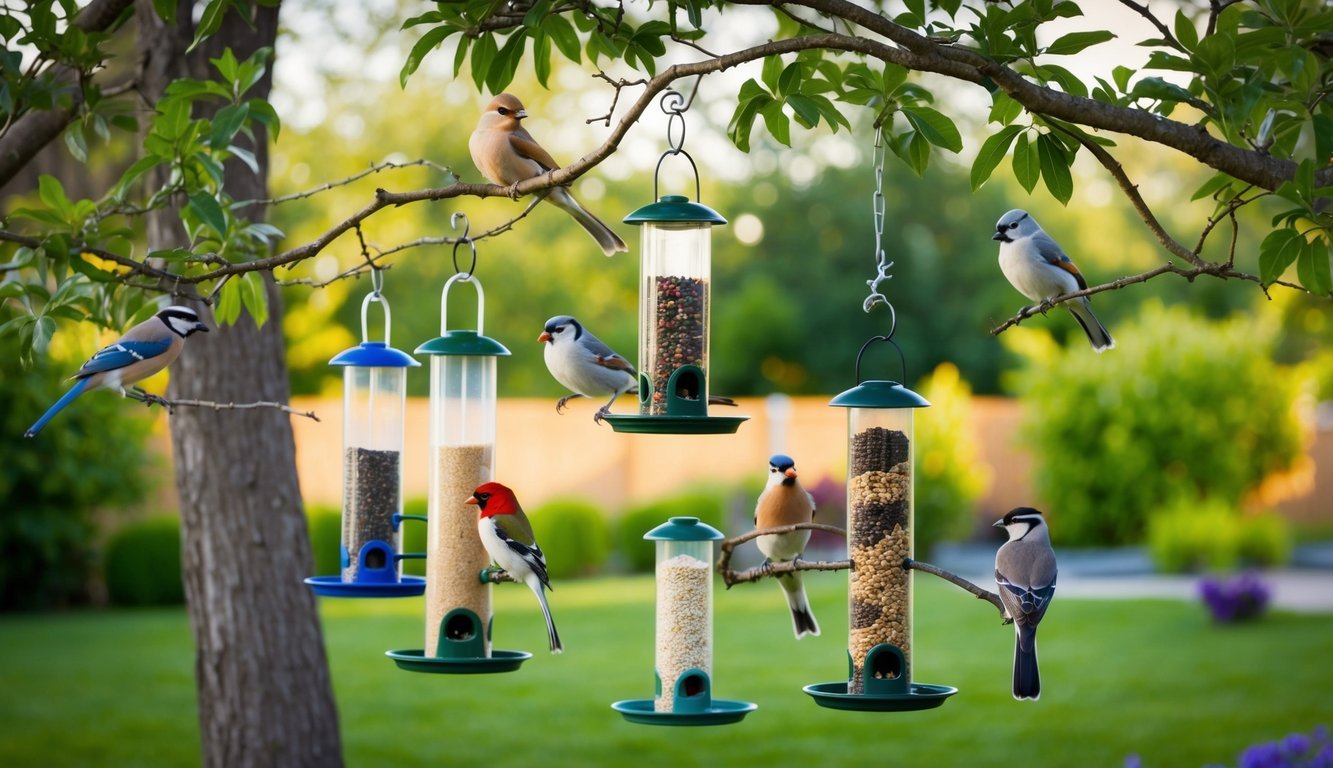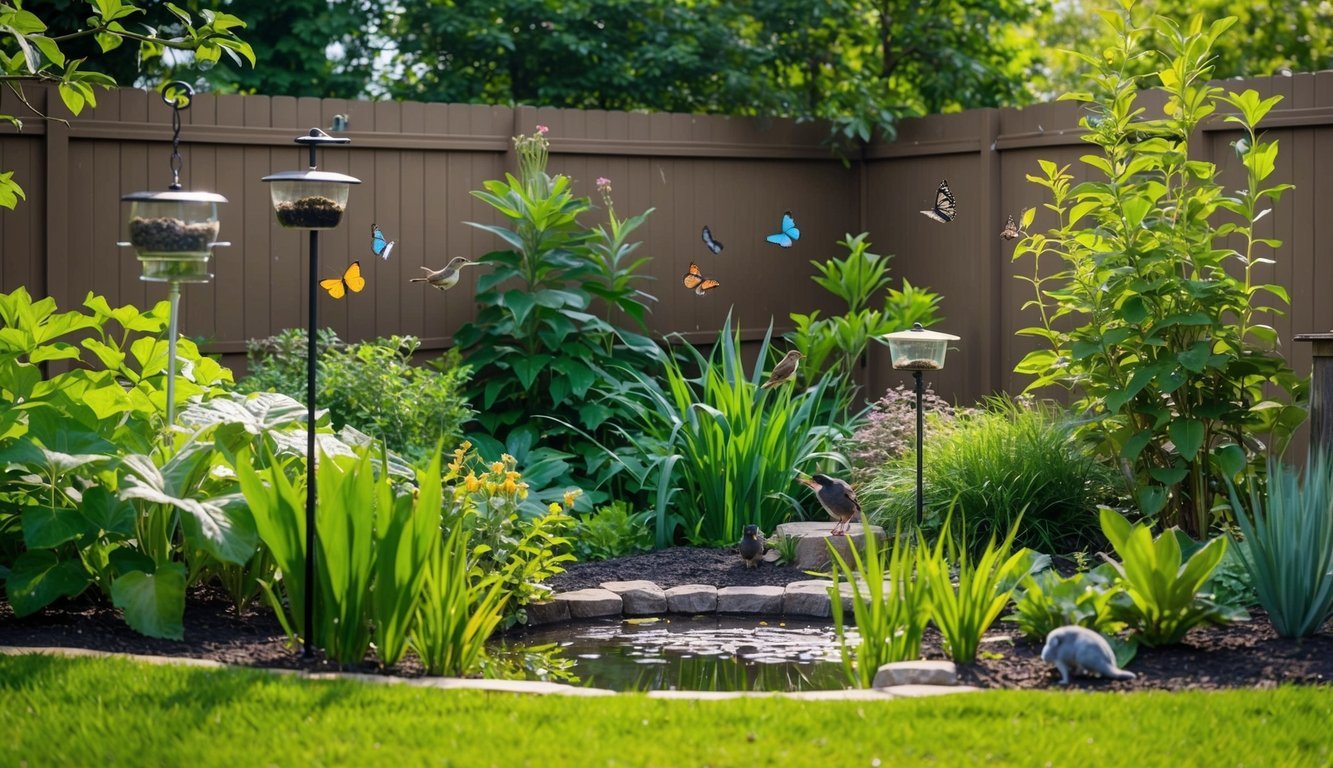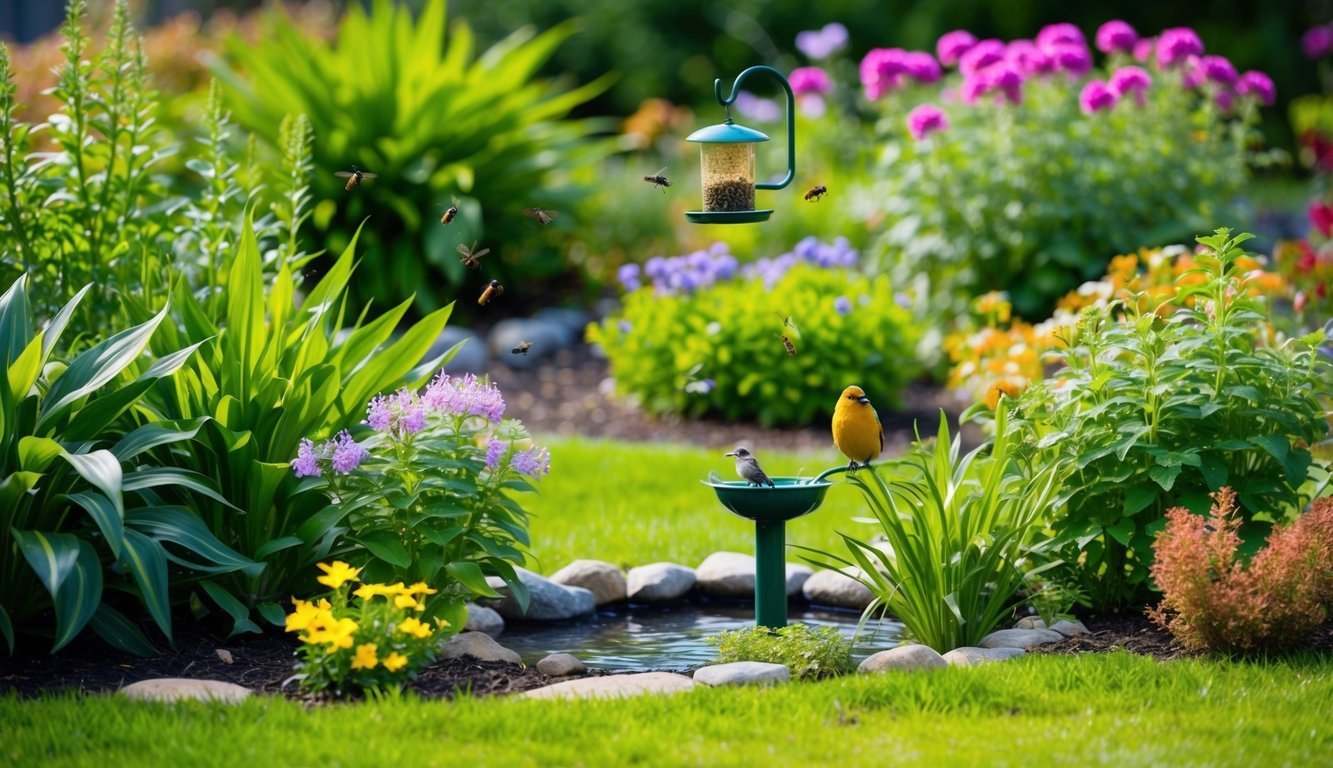Creating a wildlife sanctuary in my yard has always been a dream of mine.
It’s a simple and fulfilling way to connect with nature and support local wildlife. With just a few easy steps, I can transform my outdoor space into a haven for birds, insects, and other beneficial creatures.

By making some thoughtful changes, I can provide shelter, food, and water for various species.
This not only brings joy and beauty to my home but also contributes to the health of the local ecosystem.
Let’s explore how I can create this inviting space for wildlife.
1) Pick Native Plants
Choosing native plants is one of the simplest ways to create a wildlife sanctuary.
These plants are adapted to my region’s climate and soil, making them easier to care for.
Plus, they provide food and habitat for local wildlife.
I like to start by assessing the sun and moisture levels in my yard.
This helps me select the right plants for each spot.
Some native flowers, like sneezeweed, bloom beautifully in late summer and attract butterflies.
I also consider grouping plants in clusters.
This mimics their natural growth patterns and makes my garden more appealing to wildlife.
Using native species not only enhances my garden’s beauty but also supports the local ecosystem.
They attract pollinators like bees and butterflies, which are essential for a thriving garden.
Before I go shopping for plants, I make a list of options that fit my space.
It’s exciting to envision how these natives will transform my yard into a cozy haven for wildlife!
2) Install Bird Feeders

Installing bird feeders is one of the simplest ways to attract birds to my yard.
I choose feeders that cater to the types of birds I want to see.
There are feeders for seeds, suet, and even nectar for hummingbirds.
I make sure to place the feeders in a safe spot, away from windows and predators.
This helps keep the birds safe and encourages them to visit regularly.
I fill the feeders with fresh seeds suited to the local bird species.
Sunflower seeds are a favorite among many birds.
I also ensure to clean the feeders regularly to prevent mold and disease.
It’s important to provide fresh water, too.
I often add a birdbath near my feeders.
The sound of water attracts birds and gives them a place to drink and bathe.
With these feeders and a bit of patience, I can enjoy watching my feathered friends throughout the year.
Each season brings a new mix of visitors, making my yard lively and vibrant.
3) Create a Water Source
I find that one of the easiest ways to attract wildlife to my yard is by adding a water source.
Birds, insects, and other animals need water to drink and bathe.
If I don’t have a natural feature like a pond, I set up a simple bird bath or a small fountain.
A shallow bowl or even a hanging waterer can work wonders, too.
I make sure to keep the water fresh and clean.
Regularly refilling and changing the water prevents stagnation and keeps it appealing for the creatures visiting my yard.
Not only do these additions provide hydration, but they also create a bathing area for birds, which can be fun to watch.
My yard starts to feel lively with activity as various species come in for a quick drink or a splash.
4) Build a Bee Hotel
Building a bee hotel is a fun project that can really help local pollinators.
I like to start by gathering materials like untreated wood, hollow stems, and other natural items.
First, I cut the wood into pieces to create a rectangular frame.
I usually use four equal lengths, ensuring they’re long enough to hold the bee-friendly stems.
Next, I assemble the frame and secure it with screws.
To avoid splitting the wood, I always drill guide holes before attaching pieces together.
For the inviting part, I snip the hollow stems into lengths that fit snugly in the frame.
I avoid any bent or damaged stems since they won’t attract bees.
Once I’ve filled the frame, I find a sunny spot to hang my bee hotel.
I make sure it’s at least 3-5 feet off the ground and ideally facing southeast to catch the morning sun.
Finally, I check on it periodically to ensure it’s in good shape.
It’s a simple way to support bees and create a lively garden space.
Plant Butterfly Bushes

Planting butterfly bushes is one of my favorite steps in creating a wildlife sanctuary.
These vibrant plants are known for attracting butterflies, making them perfect for my garden.
First, I make sure to choose a sunny location.
Butterfly bushes thrive in areas with at least six hours of sunlight daily.
This keeps the plants healthy and encourages butterflies to visit.
Next, I prepare the soil.
It’s important to have rich, well-draining soil for these bushes.
I often mix in some compost to boost nutrients, ensuring the growth stays strong.
When planting, I dig a hole that’s about twice the size of the root ball.
I gently loosen the roots if they are tightly packed.
After placing the bush in the hole, I fill it back in and water it thoroughly.
Lastly, I give my butterfly bushes regular care.
Watering them weekly helps establish their roots.
Soon enough, I’ll be enjoying the beauty of butterflies dancing around my garden.
6) Go Chemical-Free

I find that going chemical-free is one of the best steps I can take to create a truly welcoming wildlife sanctuary.
It’s important to avoid pesticides and herbicides that can harm beneficial insects and other wildlife.
Instead, I focus on natural gardening practices.
For example, I use companion planting to deter pests and promote healthy plant growth.
Herbs like basil can help keep harmful insects away from my vegetables.
I also encourage nature’s helpers, like ladybugs and lacewings, by providing a habitat for them.
I leave some areas of my yard a bit wild, which attracts these beneficial creatures.
Additionally, I prefer organic fertilizers made from compost or natural materials.
They provide nutrients for my plants without the harsh effects of synthetic chemicals.
By going chemical-free, my yard feels healthier and more vibrant.
It creates a safer environment for all the critters that visit my sanctuary.
Plus, I get to enjoy a more sustainable approach to gardening.
7) Add Rock Piles
Adding rock piles to my yard is a simple yet effective way to create a welcoming habitat for wildlife.
These piles can attract a variety of creatures, from insects to small mammals.
I like to gather different sizes of rocks and arrange them in a sunny spot.
This setup provides basking areas for reptiles and shelter for insects.
It’s fascinating to see how quickly life starts to flourish around these piles.
Rock piles also serve as great hiding spots for small animals like toads and lizards.
When I check on them, I often find these critters enjoying the cool shade between the stones.
By creating a few rock piles in various locations, I can enhance the biodiversity of my yard.
The added texture and structure encourage a thriving ecosystem that benefits many species.
Understanding The Basics

Creating a wildlife sanctuary in my yard is all about appreciating and supporting local biodiversity.
I find it rewarding to know that my small efforts can make a big difference for wildlife.
Let’s dive into what a wildlife sanctuary is and explore the benefits of creating one.
What Is A Wildlife Sanctuary?
A wildlife sanctuary is a designated area where local wildlife can thrive and find refuge.
It’s a space that I’ve intentionally designed to support various species, including birds, insects, and small mammals.
To qualify as a sanctuary, my yard should provide essential elements like food, water, and shelter.
These components entice wildlife, creating a welcoming environment.
In a sanctuary, I can plant native flora, which offers natural food sources.
Moreover, a sanctuary promotes ecological balance, supporting species that might be struggling due to habitat loss.
By transforming my yard, I contribute to the preservation of these vital ecosystems.
Benefits Of Creating A Sanctuary
Creating a wildlife sanctuary offers numerous benefits, both for me and the environment.
First, I get the joy of observing diverse wildlife right in my backyard.
This connection to nature is fulfilling and adds beauty to my outdoor space.
Secondly, sanctuaries support local ecosystems.
By attracting pollinators like bees and butterflies, I help with plant reproduction, which is vital for food production.
This can also mean healthier plants and more vibrant gardens.
Another benefit is the educational aspect.
I learn about the different species visiting my yard, enhancing my appreciation for nature.
This can inspire others in my community to consider similar efforts, creating a ripple effect of environmental care.
- Supports local biodiversity
- Enhances personal well-being
- Promotes community awareness
Choosing The Right Plants

Selecting the right plants is crucial for attracting wildlife to your yard.
I focus on incorporating native species and creating diverse habitats to support different animals, insects, and birds.
Native vs. Non-Native Species
Native plants are the backbone of a wildlife-friendly garden.
They are adapted to the local climate and soil, making them easier to grow.
These plants provide essential food and shelter for native wildlife.
For example, milkweed is a top choice for attracting pollinators like butterflies.
I often choose plants like echinacea, black-eyed Susan, and dogwood because they are not only beautiful but also beneficial.
Non-native species may look appealing, but they can lack the necessary nutrients for local wildlife.
Additionally, they might outcompete native plants, ultimately diminishing biodiversity in my yard.
Creating Diverse Habitats
I prioritize diversity in plant selection to foster a thriving ecosystem.
A mix of plants can create various layers of habitat, providing shelter and food sources for different species.
I like to plant a combination of flowering plants, shrubs, and trees to cater to various wildlife.
For instance, flowering plants attract pollinators, while dense shrubs offer cover for small birds.
Incorporating features like rock piles or log piles can enhance this diversity even further, offering refuge for reptiles and insects.
Each element contributes to a more dynamic and resilient wildlife sanctuary in my yard.

